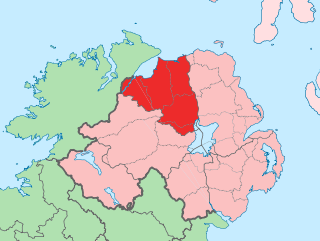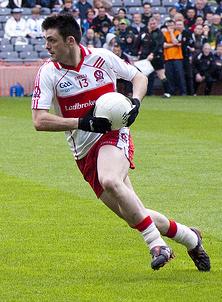
County Londonderry, also known as County Derry, is one of the six counties of Northern Ireland, one of the thirty-two counties of Ireland and one of the nine counties of Ulster. Before the partition of Ireland, it was one of the counties of the Kingdom of Ireland from 1613 onward and then of the United Kingdom after the Acts of Union 1800. Adjoining the north-west shore of Lough Neagh, the county covers an area of 2,118 km2 (818 sq mi) and today has a population of about 252,231.

Limavady is a market town in County Londonderry, Northern Ireland, with Binevenagh as a backdrop. Lying 17 miles (27 km) east of Derry and 14 miles (23 km) southwest of Coleraine, Limavady had a population of 11,279 people at the 2021 Census. In the 40 years between 1971 and 2011, Limavady's population nearly doubled. Limavady is within Causeway Coast and Glens Borough.

The Irish Football Association Challenge Cup, commonly referred to as the Irish Cup is the primary football knock-out cup competition in Northern Ireland. Inaugurated in 1881, it is the fourth-oldest national cup competition in the world. Prior to the break-away from the Irish Football Association by clubs from what would become the Irish Free State in 1921, the Irish Cup was the national cup competition for the whole of Ireland.

Castlerock is a seaside village in County Londonderry, Northern Ireland. It is five miles west of Coleraine, and part of Causeway Coast and Glens district. It is very popular with summer tourists, with numerous apartment blocks and two caravan sites. Castlerock Golf Club has both 9-hole and 18-hole links courses bounded by the beach, the River Bann and the Belfast to Derry railway line. The village had a population of 1,287 people at the 2011 census, and is where near by village Articlave F.C play their home games.
The Ulster Towns Cup is a rugby union competition organized by the Ulster branch of the Irish Rugby Football Union.

Eoin Bradley is a Gaelic footballer and association footballer. He plays the former for the Glenullin club and, previously, for the Derry county team. With Glenullin he won a Derry Senior Football Championship and with Derry he won a National League title. He also plays association football as a striker for Portadown.
Felix Healy is a former Northern Ireland international footballer and singer who played for Coleraine and then became a football manager. He has also worked as a media pundit and is currently part of the management team at First Division club Finn Harps, taking on the role of Director of football alongside manager Peter Hutton.
The North West Senior Cup or North West Cup is a senior football competition in Northern Ireland run by the North West of Ireland Football Association. Senior and intermediate teams from the North West FA's jurisdiction, are entitled to enter. It originated as the County Londonderry F.A. Cup in 1886–87 but became the North West Cup in 1892.
The Irish Intermediate Cup is a Northern Irish football competition for teams of intermediate status, including NIFL Premiership reserve sides. It is a straight knock-out tournament and is currently sponsored by McCombs Coach Travel.
Derry Olympic Football Club was a football team from Derry, Ireland that was a member of the Irish League for the 1892–93 season.

Causeway Coast and Glens is a local government district covering most of the northern part of Northern Ireland. It was created on 1 April 2015 by merging the Borough of Ballymoney, the Borough of Coleraine, the Borough of Limavady and the District of Moyle. The local authority is Causeway Coast and Glens Borough Council.
The North West Senior Cup is the most important provincial cricket knock-out cup of the North West jurisdiction in Ireland. The competition is open to teams playing in the North West Senior League. It is sponsored by Bank of Ireland and marketed as the Bank of Ireland Senior Cup.
Coleraine Cricket Club is a cricket club in Coleraine, County Londonderry, Northern Ireland, playing in North West Senior League Premiership. They are affiliated with the North West Cricket Union and Cricket Ireland. The club was founded as the cricket section of Coleraine Rugby Football Club in 1958 and later merged with the University of Ulster at Coleraine team.
The 2004–05 Irish Cup was the 125th edition of the Irish Cup, Northern Ireland's premier football knock-out cup competition. It concluded on 7 May 2005 with the final.

The Northern Ireland Football League, known historically as the Irish League, is the national football league of Northern Ireland. The Irish League was originally formed in 1890, with the league in its current format created in 2013 to assume independent collective management of the top three levels of the Northern Ireland football league system; namely the Premiership, Championship and Premier Intermediate League.
Wellington Park Football Club is a former Irish football club from Belfast.
The Dublin Association Football Club was an association football club based in Dublin, Ireland. Dublin Association was the first football club to be formed in Dublin and the first club outside of Ulster to be affiliated with the Irish Football Association. The club existed between 1883 and 1890 and played in the Irish Cup.
The 1892–93 Irish Cup was the 13th edition of the Irish Cup, the premier knock-out cup competition in Irish football.
Banbridge Football Club is a former Irish football club, from the town of Banbridge, and was one of the first four clubs to be formed in Ireland.







